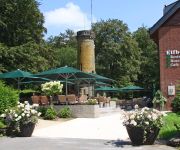Facts and Data
Webpages:
Official Unesco Page
Basis Data:
Unesco World heritage since: 2013
Size of heritage: 559 ha
- Buffer zone: 2,666 ha
Coordinates:
Longitude: 9,393°
Latitude: 51,316°
Summary
Descending a long hill dominated by a giant statue of Hercules, the monumental water displays of Wilhelmshöhe were begun by Landgrave Carl of Hesse-Kassel in 1689 around an east-west axis and were developed further into the 19th century. Reservoirs and channels behind the Hercules Monument supply water to a complex system of hydro-pneumatic devices that supply the site’s large Baroque water theatre, grotto, fountains and 350-metre long Grand Cascade. Beyond this, channels and waterways wind across the axis, feeding a series of dramatic waterfalls and wild rapids, the geyser-like Grand Fountain which leaps 50m high, the lake and secluded ponds that enliven the Romantic garden created in the 18th century by Carl’s great-grandson, Elector Wilhelm I. The great size of the park and its waterworks along with the towering Hercules statue constitute an expression of the ideals of absolutist Monarchy while the ensemble is a remarkable testimony to the aesthetics of the Baroque and Romantic periods.
Location on Map
Show bigger map on Openstreetmap
Introduction
Bergpark Wilhelmshöhe is a UNESCO World Heritage site located in Germany, specifically in the city of Kassel. This magnificent park is renowned for its stunning landscape, impressive water features, and historical significance. With a rich history dating back to the 17th century, Bergpark Wilhelmshöhe has become a popular tourist destination and a symbol of cultural heritage.
History
The construction of Bergpark Wilhelmshöhe began in 1696 under the rule of Landgrave Charles I of Hesse-Kassel. The park was initially designed as a Baroque garden, inspired by the Italian Renaissance. Over the years, various rulers and architects contributed to its expansion and transformation, resulting in a unique blend of architectural styles.
One of the most notable additions to the park is the Hercules monument, which was completed in 1717. This colossal statue of Hercules stands at the top of a pyramid-shaped structure and serves as the centerpiece of the park. It symbolizes the strength and power of the ruling dynasty.
During the 18th and 19th centuries, the park underwent further enhancements, including the addition of water features. The most impressive of these is the Grand Cascade, a series of waterfalls and fountains that stretch over 350 meters. The water is supplied by a reservoir located at the top of the park, creating a breathtaking spectacle when the fountains are in operation.
Current State
Today, Bergpark Wilhelmshöhe is meticulously maintained and open to the public. It offers visitors a unique opportunity to explore its vast grounds and experience the beauty of its natural and architectural elements.
The park covers an area of approximately 2.4 square kilometers and features a network of walking paths that lead visitors through its various attractions. From the Hercules monument at the top of the park, visitors can enjoy panoramic views of the surrounding landscape.
The water features, including the Grand Cascade, are still operational and are a major highlight of the park. During the summer months, the fountains are regularly turned on, creating a mesmerizing display of water and sound. This attracts both locals and tourists who gather to witness this spectacle.
In addition to its natural and architectural wonders, Bergpark Wilhelmshöhe also houses the Wilhelmshöhe Palace. This magnificent palace, built in the neoclassical style, serves as a museum and showcases a collection of art and historical artifacts.
The park is also home to a variety of flora and fauna, making it an ideal destination for nature enthusiasts. The diverse plant species and well-preserved habitats provide a haven for wildlife, including birds and small mammals.
Conclusion
Bergpark Wilhelmshöhe is a UNESCO World Heritage site that combines history, art, and nature in a harmonious manner. Its rich history, stunning water features, and well-preserved landscape make it a must-visit destination for anyone interested in cultural heritage and natural beauty. Whether strolling through its paths, admiring the Hercules monument, or witnessing the grandeur of the Grand Cascade, visitors to Bergpark Wilhelmshöhe are sure to be captivated by its timeless charm.
Hotels and places to stay
Waldhotel Elfbuchen
Schlosshotel Bad Wilhelmshöhe Conference & Spa
Palmenbad
Zum Steinernen Schweinchen
Hotel am Herkules
MountainPark Hotel
Am Bergpark Neue Drusel
Villa Andante Apartmenthotel garni
Am Sonnenhang
Neu-Holland
Videos from the area
Videos provided by Youtube are under the copyright of their owners.

















